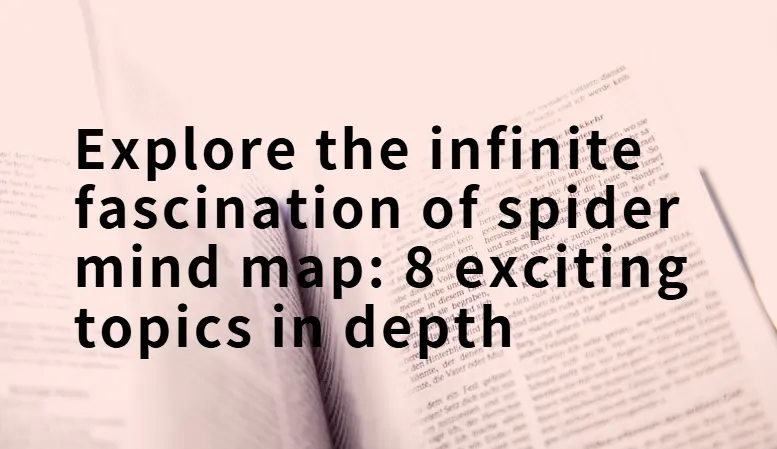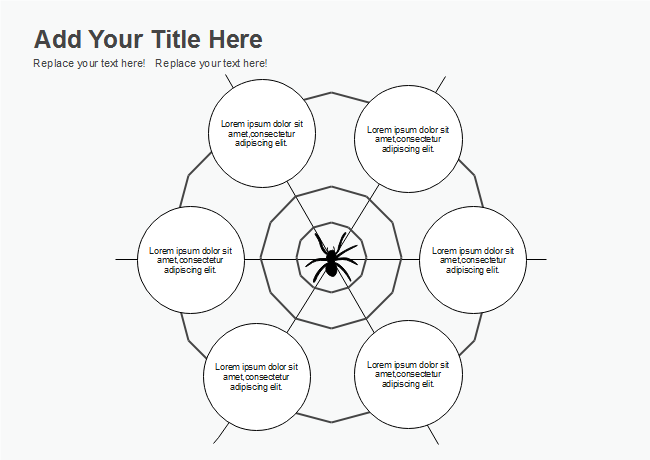
Mindmaps or Traditional Notes: Finding Your Ideal Method
Compare mindmaps and traditional notes to find your ideal method. Explore their benefits, applications, and decide which suits your learning style.
Education Consultant

In the vast field of knowledge management and information visualization, spider web diagrams (also known as mind maps or radioactive mind maps), as a highly efficient cognitive tool, have gradually taken their place in academic research and practical applications by virtue of their intuitiveness, systematicity and flexibility. Through the branching structure radiating outward from the central node, Spider Web Diagram not only can effectively organize complex information, but also promotes the dispersion and aggregation of thinking, and becomes a bridge connecting abstract concepts and concrete details.
Spider Web Diagram, as a graphical representation of thinking, is centered on the use of a central theme as a starting point, extending multiple sub-themes or associated concepts in all directions to form a tightly connected, hierarchical knowledge network. Its advantages lie in the following: firstly, it can intuitively show the logical relationship between information and help users to quickly grasp the overall framework; secondly, through visual presentation, it reduces the cognitive load of information processing and improves the efficiency of information absorption and memorization; lastly, the dynamic updating characteristics of the spider web diagram make it adaptable to the ever-changing thinking process and promote the generation of creativity and problem solving.

Image from:Free Spider Map Graphic Organizer Templates (edrawsoft.com)
The reasons for selecting the following eight specific themes for spiderweb mapping in this study are mainly based on the following considerations: first, these themes cover a wide range of fields such as project management, education, personal development, creative industry, knowledge management, event planning, interpersonal relationship analysis and health management, which are widely representative and practical; second, the tasks and problems in these fields often involve complex information structures and multi-level relationship networks, which are suitable to be sorted out and presented through spider web diagrams; thirdly, through the application of spider web diagrams, the inherent logical laws and thinking patterns in these fields can be revealed, and new perspectives and tools can be provided for the research and practice in related fields.
In the following chapters, we will explore eight themes in depth one by one, and through the comprehensive analysis of these eight themes, we aim to show the prospect of the wide application and far-reaching impact of Spider Web Diagram as a powerful thinking tool.
In the project initiation phase, through the construction of a spider web diagram, project managers can focus on the core project objectives (such as “new product release”) as the central node, and radiate outward to a number of key branches, each branch represents a key area or sub-tasks. Specifically, these branches can cover the specificity of the project objectives, task decomposition and responsibility allocation, detailed planning of the timeline, and the evaluation and deployment of resources (including human, material and financial resources). The hierarchical structure and connectivity of the Spider Web Diagram not only visualizes the logical relationship between the various elements of the project, but also promotes communication and collaboration among team members to ensure that the project planning is comprehensive, systematic and operable.
As the project progresses, factors such as the project environment, objectives or resources may change. Therefore, project managers need to review and adjust the Spider Web diagram regularly to ensure that it is consistent with the actual project situation. Encourage team members to participate in the construction and maintenance of the Spider Web Diagram, and utilize collective wisdom to improve the comprehensiveness and accuracy of project planning. At the same time, through the sharing of the spider web diagram, to promote communication and collaboration between team members, to reduce information asymmetry. Establish standards and norms for drawing spider web diagrams, such as unified symbols, colors, hierarchical structure, etc., in order to improve the clarity and readability of the diagrams. At the same time, establish the updating and approval process of the spider web diagram to ensure its authority and effectiveness in project management. Use professional project management software or online tools to draw and manage spider web diagrams. These tools usually provide rich templates, customization options, and data integration functions, which help to improve the efficiency and quality of project management.

Image from: canva
At the syllabus design stage, educators can use the core-center radial structure of the spider web diagram to place the course topic at the center, and subsequently develop multi-level branches around it to represent the various components of the course. Specifically, these branches can cover the concretization of course objectives (e.g., knowledge acquisition, skill enhancement, attitude development, etc.), the modularization of course content (divided into chapters, topics, or units of study), and the diversification of assessment methods (including exams, homework assignments, classroom performances, and project practices, etc.). The use of spider web diagrams not only makes the course outline present a clear logical structure and hierarchical relationship, but also facilitates educators to flexibly adjust and supplement the content during the teaching process in order to adapt to students’ learning needs and changes.
Spiderweb maps are also uniquely suited to promote independent learning and revision. Educators can encourage students to use spider maps for self-learning planning, turning key information in the course syllabus into a personalized learning roadmap. Students can mark key points, difficulties and problems to be solved on the Spider Maps according to their own learning progress and comprehension level, so as to realize the in-depth processing and integration of learning content. In addition, during the revision stage, the Spider Web Map can also help students quickly review the curriculum, grasp the links and differences between knowledge points, and improve the efficiency and effectiveness of revision.
In the process of personal goal setting, the cobweb diagram, through its center-radiating structure, prompts individuals to place their core goals at the center and consider them in multiple dimensions and levels. This process not only requires individuals to clarify the specific content of their goals (e.g., career advancement, academic achievement, quality of life enhancement, etc.), but also to further refine the hierarchy of their goals and distinguish between long-term and short-term goals. The branches of the cobweb diagram carry key information such as specific steps, key resources, potential obstacles, and coping strategies needed to achieve these goals. By drawing the cobweb diagram, individuals can visualize the whole picture of the goal and the path to achieve it, thus enhancing the operability of the goal and the possibility of achieving it.
Spiderweb diagrams show significant positive effects in enhancing self-knowledge and motivation. First of all, through drawing the spider web diagram, individuals can examine their inner world and outer environment more deeply, thus enhancing the depth and breadth of self-knowledge. This process helps individuals recognize their strengths and weaknesses more clearly, which provides strong support for subsequent goal setting and achievement. Secondly, the spider’s web diagram stimulates individuals’ intrinsic motivation and enthusiasm with its intuitive and systematic nature. Seeing clear paths and steps to achieve the goals, individuals are more likely to generate the impulse to act and perseverance, and thus more actively participate in the process of goal realization. In addition, the Spider Web Diagram also encourages individuals to conduct continuous self-reflection and adjustment in the process of realizing their goals to adapt to the changes in the external environment and the needs of their own growth, thus promoting the overall improvement and development of their personal capabilities.

Image from:Home (pinterest.com)
The Spider Web diagram builds an open and flexible framework for the creative process through its unique center-radial structure. In creative brainstorming, this framework serves as a bridge for the dispersion and convergence of ideas. Individuals or teams can start from a core concept or problem, freely associate around it, and record all kinds of ideas, opinions, and related information in the form of branches. This process not only promotes the free flow of ideas, but also helps participants clearly see the connections and differences between ideas through visualization, making it easier to discover new creative ideas or solutions. At the same time, the editable nature of the spider web diagram makes it possible to iterate and optimize ideas, and as the discussion deepens and information is added, the creative solutions can be gradually improved.
With its intuitive and structured characteristics, the spider web diagram shows unique advantages in knowledge organization and review. It can help learners connect scattered knowledge points to form a logical and clear hierarchical knowledge system. In the process of drawing the spider web diagram, learners need to process the learned knowledge in depth, refine the core concepts and key elements, and make clear the intrinsic connection between them. This process not only promotes the internalization and understanding of knowledge, but also enhances the learners’ ability to grasp knowledge as a whole. At the same time, the visual presentation of spider web diagrams helps activate the visual memory system of the brain, making knowledge more vivid and concrete, thus improving the effect of memorization.
In the process of event planning and management, the cobweb diagram places the main elements of the event (e.g. theme, time, place, budget, participants, etc.) in the center through its central radial structure, and carries out detailed planning and resource deployment around these elements. By drawing a spider web diagram, planners can clearly see the whole picture of the event, including the interconnections and dependencies of each link, thus ensuring the completeness and systematization of the planning. In addition, the cobweb diagram also allows planners to update information and adjust plans to meet changes and needs in the preparation process.
In the broad fields of literary creation, historical research, and modern interpersonal analysis, the complexity of character relationships is often the key to understanding the story line, historical process, or social structure. As an intuitive and structured visualization tool, Spiderweb Diagram, with its unique characteristics of central radiation and branching expansion, provides strong support for clarifying these complex relationships.
The application of spider web diagram in character relationship sorting centers on its ability to clearly show the direct and indirect connections between individuals, forming an intricate but well-organized relationship network. In novel creation, it helps writers build a multi-dimensional character interaction network and deepen the emotional entanglements and conflicts of interest between characters; in historical research, spider web diagrams become an effective means to reveal the complex relationships between historical figures, such as power struggles, alliances, and betrayals; and in interpersonal relationship analysis, especially in social network analysis, it intuitively presents the social connections and influence distribution among individuals or groups. In interpersonal relationship analysis, especially in social network analysis, it visualizes the distribution of social connections and influence among individuals or groups.
In the complex process of health promotion and habit formation, the Spider Web Diagram, as a comprehensive visual tool, provides an efficient management framework for individuals with its structured and dynamically updated nature. The tool not only helps to clarify health goals and refine action steps, but also guides strategy adjustments during continuous tracking and evaluation, achieving long-term maintenance and optimization of health behaviors.
Health and habit management is a multi-dimensional and multi-level systematic project involving diet, exercise, sleep, mental health and other areas. The Spider Web Diagram takes these key areas as the core nodes and extends them outward to specific goals, action plans, and measurement indicators through its center-radial structure. This visualization process not only enhances the clarity and operability of the goals, but also promotes the establishment of self-monitoring and feedback mechanisms, enabling individuals to visualize their progress and deficiencies, thus stimulating the motivation for continuous improvement.
The Spider Web Diagram helps learners to build a systematic knowledge system and strengthen their memory by organizing and reviewing knowledge; in event planning and management, it serves as a powerful assistant for planning and monitoring, ensuring the smooth implementation of activities and effective management of risks; and in health and habit management, the Spider Web Diagram promotes the continuous development and improvement of health behaviors by setting clear goals, tracking progress and adjusting strategies. In health and habit management, the spider web diagram promotes the continuous development and improvement of health behavior by setting clear goals, tracking progress and adjusting strategies. In addition, in the fields of novel writing, historical research, and interpersonal relationship analysis, Spider Maps also play an irreplaceable role, providing researchers and creators with brand-new perspectives and tools.

Compare mindmaps and traditional notes to find your ideal method. Explore their benefits, applications, and decide which suits your learning style.
Education Consultant
.BOgX9RtS_ZU8DN8.webp)
Uncover the purpose and diverse applications of concept maps in organizing ideas, enhancing understanding, and visualizing relationships across various fields.
Researcher @ University of Cambridge

A step-by-step guide to effectively brainstorming with mindmaps.
Education Consultant